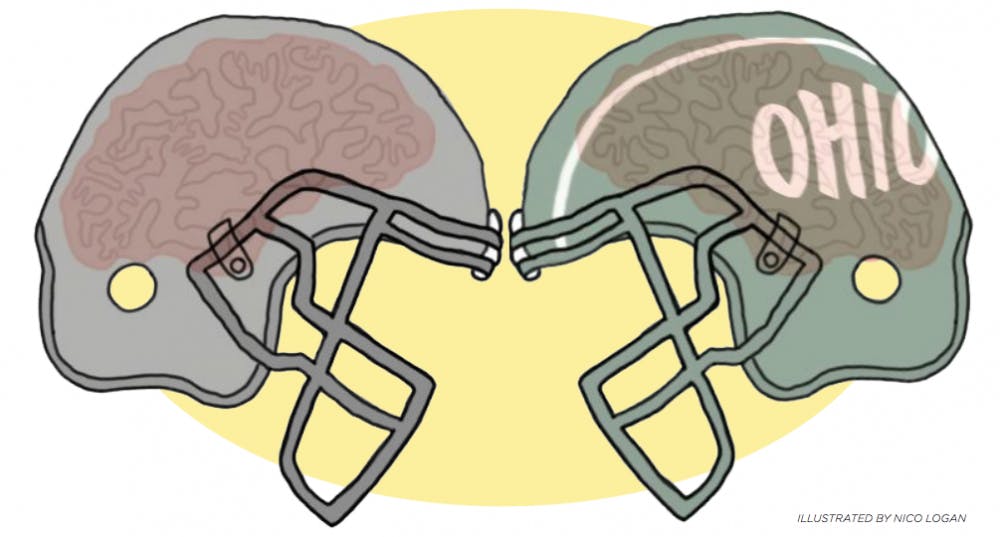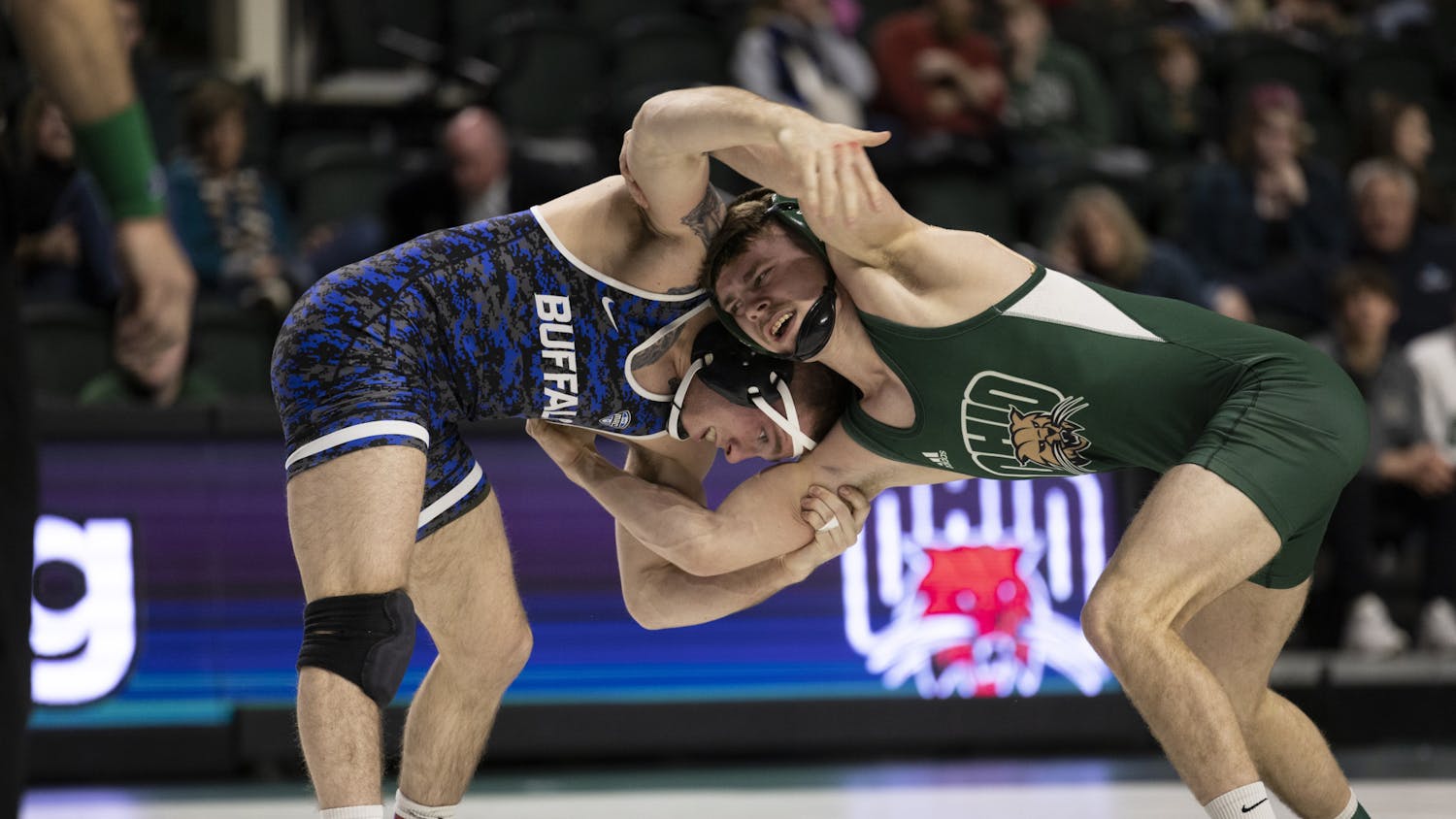Concussions are a problem throughout football, although information is not always diverged to the public.
Two weeks ago, Ohio football’s Ian Wells lined up as cornerback hoping to stop an Eastern Illinois drive and keep momentum in the Bobcats’ favor. The ball was snapped and Eastern Illinois’ quarterback tossed a simple screen pass, but one of the Bobcats linebackers missed his tackle leaving Wells with the task of stopping the play without allowing a first down.
Wells, a redshirt junior cornerback, launched himself at the receiver to make a tackle and stop the play.
“He didn’t get a first down, so I guess that’s a plus,” he said.
But it gave Wells a concussion that sidelined him for a week, including last Saturday’s game against Central Michigan.
It wasn’t his first concussion. He had two others in high school during his sophomore and senior years.
Luckily for Wells, he realized he was injured and rushed to the sideline to get off the field in attempt to not further injure himself. The Ohio trainers conducted a neurological evaluation on him and prevented him from re-entering the game.
Collegiate athletic departments aren’t required to disclose student-athletes’ injury information to the public under the Family Educational Rights and Privacy Act, so there are no exact numbers detailing exactly how many student-athletes suffer concussions.
After the Eastern Illinois game, Ohio coach Frank Solich said Wells “should be fine” to play last Saturday at Central Michigan, but Wells ended up not even traveling to the game.
Researchers found that 26 of 27 potential concussions go unreported by college football players, according to a study conducted by Harvard University and Boston University,
That was Wells’ third diagnosed concussion, but he said it doesn’t affect how he plays the game. Players aren’t encouraged to lower their heads while making a tackle because it puts them at a greater risk of suffering an injury, but sometimes that’s the only way they can make one.
“I feel like if you are hesitant with certain injuries and how you injured yourself before, that’s how you re-injure yourself,” Wells said. “It’s not in the back in my mind.”
Treatment
The NCAA defines a concussion as a change in brain function after a hit to the head, which may be accompanied by temporary loss of consciousness. However, there are different symptoms for each injury and not every person loses consciousness.
John Bowman, Ohio’s assistant athletic director for sports medicine, said if he saw 10 concussions, each would have a unique quality about them and no three would be identical. He also said concussions can’t always immediately be diagnosed.
“It’s difficult evaluating a concussion because it changes,” Bowman said. “If you don’t see anything and they’re absolutely fine you let them go, but you go back and check them again. That does happen where all of a sudden they show symptoms.”
Coaches will look for dazed eyes, poor balance, loss of consciousness and other confusion. Athletes, on the other hand, will also experience pressure in their head, dizziness, double vision or sensitivity to light — each of which isn’t always visible to outsiders.
After being diagnosed, Wells was ruled out for the second half of the game against Eastern Illinois and spent it on the sideline out of his shoulder pads. He then was told to remain home and rest until Wednesday, which he said was the worst part.
On Thursday, Athletics told him to return for a cardio workout, but was sent back home until meeting with doctors again Friday. After almost an entire week away from football-related activities, he showed no more symptoms, has since returned to practice and will play this weekend against Bowling Green.
Bowman said most collegiate athletes will heal in two to three days; the more mature a person’s brain is, the quicker it will heal.
“It’s a big problem because the guys today are bigger and faster and running with their head down and stuff,” Wells said. “It’s a fast-paced game and you’re not really thinking about it in the moment.”
Tim Edmond, a senior running back, has been on the other end of head-on collisions.
Edmond was once a linebacker, but has made the transition to running back as someone who can run with power and muscle through opposing defenses. In the Bobcats’ first home game against Idaho he received just one carry but he made the most of it. Edmond ran 13 yards and plowed through a defender.
“When I hit him, his helmet came off and his head like dragged to the floor,” he said. “He spit two teeth out. I was like ‘Oh, man.’ To be honest, I felt bad.”
While Edmond has never been diagnosed with a concussion, he said that football puts him at a high risk of suffering one, but agreed with Wells — he won’t change his style of play.
“When I get the ball, I’m hitting,” Edmond said. “I’m not the kind of person to worry about that. For the love of the game, if it happens, it happens.”
The next week — the same game as Wells’ injury — Edmond was passed the ball and he ran for a gain of eight yards. That time his helmet came off, but he wasn’t injured.
A problem everywhere
The same Saturday that Wells was concussed, Michigan quarterback Shane Morris suffered the same injury, but in front of a larger audience.
After throwing a pass downfield, Morris suffered a helmet-to-helmet hit and “roughing the passer” was called. He gimped after getting up from the tackle and needed help from his linemen to remain upright, but stayed in for the next play. Morris then exited to the sideline, before being re-inserted for yet another play.
Michigan’s coach Brady Hoke claimed there was a “miscommunication” about Morris’ injury, which he thought dealt with his ankle because all he saw was limping after the tackle. The head athletic trainer didn’t see the hit either, so Morris wasn’t immediately given a neurological evaluation.
Morris did have a concussion.
Hoke and Michigan’s Athletic Director Dave Brandon later issued an apology and said they made a “mistake” leaving him in the game. Protesting students still called for them to be fired.
Michigan will have a medical professional in the press box at future games after Morris’ injury so there aren’t future miscommunications, Brandon said.
But that won’t stop players from suffering injuries.
{{tncms-asset app="editorial" id="269df9d6-4f4f-11e4-ab71-0017a43b2370"}}
Prevention
As football-related concussions have come to the forefront of conversations, the NCAA and colleges nationwide have taken extra precautions.
Ohio has trainers on the offensive and defensive benches hydrating and attending to athletes, which is the most important part of preventing injuries, Bowman said.
He also rotates through the sideline and looks into players’ eyes every two or three series.
“Either we see the athlete stunned or go down, or in a game, they’ll come off and not be answering the right questions when a coach is talking to them or appeared to be slow down,” Bowman said.
Technology has also allowed for greater protection.
All players at Ohio are fitted with Riddell Revolution Speed helmets, which have padding around the inside covering the skull, said Jordan Murry, an intern for the Bobcats equipment staff.
The equipment staff fits each player in their respective helmets, ensures the chinstrap covers the jawline and that there isn’t too much air between the helmet and their head.
Despite these precautions, there is no way to be sure it won’t come off during game play, Murry said.
“Our helmets don’t come off because they’re too big or not fit right,” Murry said. “I’d be willing to bet that every situation where a helmet has come off for a kid on our team it was either unfortunately pulled off or an incidental contact at another angle caused it to come off.”
The NCAA has also limited live contact practices to just two per week during the season, meaning “any practice that involves live tackling to the ground and/or full-speed blocking.”
On full-contact days, the Ohio coaching staff runs a tackle circuit drill in practice, Edmond said. The drill is designed to teach offensive and defensive players how to tackle with correct form, rather than leaning with their heads.
“The whole Ohio staff, trainers and coaches, they’ve been wonderful about teaching us how to block correctly and tackle,” Edmond said. “It does get annoying at times, but at the same time it taught yourself how to run and tackle.”
@chadlindskog
cl027410@ohio.edu






